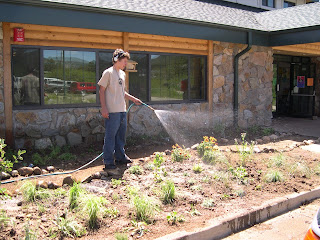Those of us living in Colorado should be fully aware of Colorado Water Law as it applies to domestic water rights and crop irrigation. Those gardeners who are fortunate enough to live in a municipality that supplies their water do not feel the restriction of water use nearly as strongly as those who receive their water by way of a residential well. Further, those with residential wells that were in place before 1972 do not feel the restrictions in place as those who have wells drilled after 1972 where outside irrigation is prohibited. (But do note that even those with household-use only wells are allowed to collect up to 110 gallons of rainwater from a residential roof). Water restrictions or not, as gardeners we should all be aware of the importance of being conservative with our water use. This is especially important in 2018 where over half of our state is experiencing drought anywhere from moderate to extreme.

If you have healthy, well amended soil you have a good chance for having soil that will hold sufficient water for your plants to thrive. Organic matter in the soil should be at 4%-5% of the makeup of the soil. Sandy soil needs amendments to give the soil more structure so that the water does not run through it too quickly. Clayey soil needs amendments to give the soil pores so that it can breathe and the roots have room to expand. Also, amendments in clayey soil help to keep the soil from being overly compacted. Vegetable plants utilize about ¼ inch of water per day. This may vary depending on temperature,wind and soil condition. Therefore, water a garden 1 inch would require watering every 4th day.
Checking Soil Moisture
Checking your soil moisture is important so that the gardener can determine whether or not the garden has sufficient moisture. The gardener should irrigate the garden once the soil feels dry to the touch at a depth of 2-4 inches. I have found that using a houseplant watering meter to be very helpful in evaluating the soil moisture content.
o Plant in blocks, rather than rows. This creates shade for roots and reduces evaporation.
o Control weeds that compete with vegetables for water.
o Protect plants and soil from wind with windbreaks to reduce evaporation.
o I have had the best success with using floating row covers. These provide moderate shade and help to reduce evaporation, while still allowing adequate sunlight and rain water to get through.
Critical Water Periods for Vegetables
Be aware of the most critical times to water your garden. Water is most critical during seed germination, the first few weeks of development, immediately after transplanting, and during flowering and fruit production. There are many methods that we can employ to be efficient in the use of water in our vegetable gardens while at the same time realizing that an adequate supply of water during the growing season is directly related to the quality and yields of our produce. There are several methods that can be used to conserve water and still have a productive vegetable garden.
Hand watering
The simplest and often most efficient method of watering is just to hand-water with a hose. This allows the gardener to see exactly the amount of water that is needed, and to direct it to specific plants.
Utilizing a drip system can reduce the need for watering up to 50% over sprinkler irrigation. It is especially efficient for block styled gardens and raised beds. Soaker hoses, in-line tubing with emitters and bubblers or drippers are all methods that can be utilized in a drip system. Soakers can be buried a little under the soil or mulch. Burying the hose can also protect it from early breakdown by the sunlight. One challenge of a drip system is the need for clean water. If the water source is not clean the hoses can become clogged.
Sprinkler Irrigation
With sprinkler irrigation, the amount of water being delivered can be easily measured. Sprinkler irrigation should discouraged on vegetables prone to foliar diseases such as Early Blight (tomatoes, peppers, and potatoes). Sprinkler irrigation also soaks the entire ground thus promoting weed growth, and it also evaporates more in the air, and thus is less efficient.
Furrow Irrigation
For gardeners who have irrigation water from a ditch, furrow irrigation in the traditional row-style garden layout may be the easiest way to water your vegetables, but not necessarily the most water-efficient. Soil erosion, potential weed deposition and runoff are major disadvantages of furrow irrigation.
For more in depth reading about watering the vegetable garden and irrigation of the garden please refer to the following CMG GardenNotes, which can be found at http://www.cmg.colostate.edu/GardenNotesUpdate.shtml#cmg.
#714 Irrigating the Vegetable Garden http://cmg.colostate.edu/Gardennotes/714.pdf
#716 Water Conservation http://cmg.colostate.edu/Gardennotes/716.pdf




Tidak ada komentar:
Posting Komentar